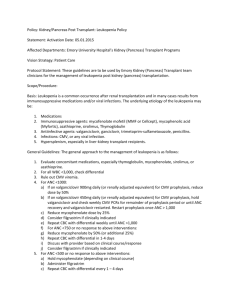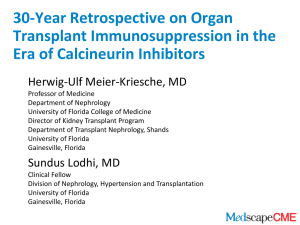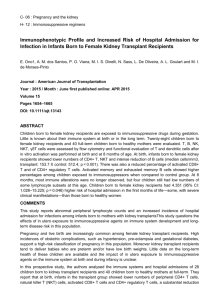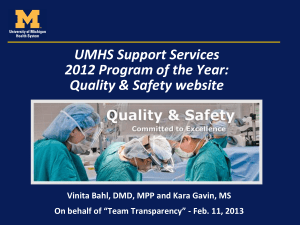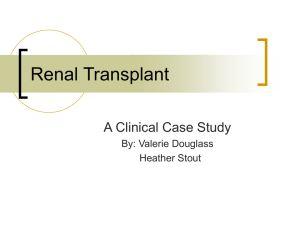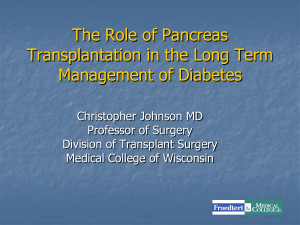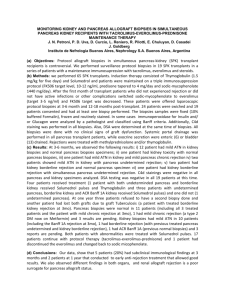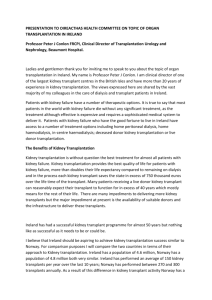31/36 passing = 86% to pass Immunosuppressive Therapy and
advertisement
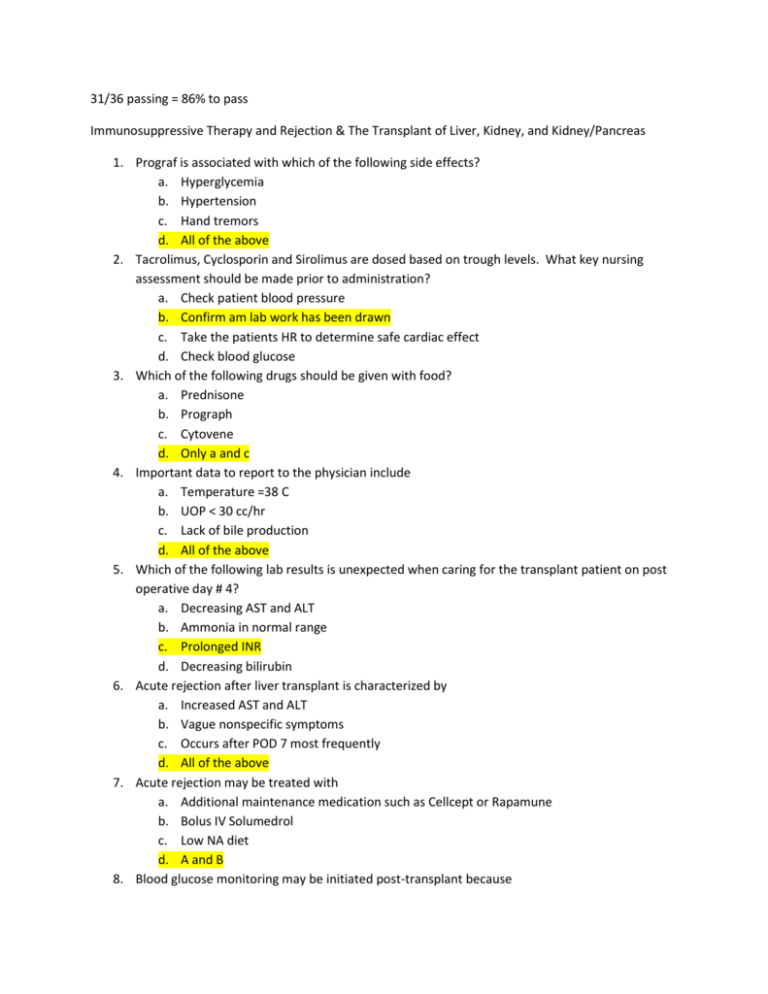
31/36 passing = 86% to pass Immunosuppressive Therapy and Rejection & The Transplant of Liver, Kidney, and Kidney/Pancreas 1. Prograf is associated with which of the following side effects? a. Hyperglycemia b. Hypertension c. Hand tremors d. All of the above 2. Tacrolimus, Cyclosporin and Sirolimus are dosed based on trough levels. What key nursing assessment should be made prior to administration? a. Check patient blood pressure b. Confirm am lab work has been drawn c. Take the patients HR to determine safe cardiac effect d. Check blood glucose 3. Which of the following drugs should be given with food? a. Prednisone b. Prograph c. Cytovene d. Only a and c 4. Important data to report to the physician include a. Temperature =38 C b. UOP < 30 cc/hr c. Lack of bile production d. All of the above 5. Which of the following lab results is unexpected when caring for the transplant patient on post operative day # 4? a. Decreasing AST and ALT b. Ammonia in normal range c. Prolonged INR d. Decreasing bilirubin 6. Acute rejection after liver transplant is characterized by a. Increased AST and ALT b. Vague nonspecific symptoms c. Occurs after POD 7 most frequently d. All of the above 7. Acute rejection may be treated with a. Additional maintenance medication such as Cellcept or Rapamune b. Bolus IV Solumedrol c. Low NA diet d. A and B 8. Blood glucose monitoring may be initiated post-transplant because 9. 10. 11. 12. 13. 14. 15. 16. 17. a. Liver failure leads to hypoglycemia b. Patients are not able to metabolize food for at least 5 days c. Some immunosuppressive agents contribute to hyperglycemia d. We want people to be stuck multiple times per day Which statement is true of acute liver failure? a. Cirrhosis is common b. Onset of symptoms to failure is < 8 weeks c. You can live with failure for years d. It is reversible with steroids Which condition is a contraindication for liver transplant? a. Extrahepatic cancer b. Active substance abuse c. Active severe infection outside biliary tree d. All of the above Transplant Nurse Coordinators are available a. For patient, family and staff as a resource for support and education b. 24/7 by pager c. In both inpatient and outpatient settings d. All of the above Critical lab values for determining a patient’s priority for liver transplant are a. PT, bilirubin and INR b. INR, bilirubin and Na c. INR, bilirubin and creatine d. Albumin, PT and creatine Hyperacute Rejection in the kidney transplant patient is caused by infection a. True b. False Hyperacute Rejection is a treatable condition a. True b. False End Stage Renal Disease that leads to kidney transplantation is the result of which of the following diseases: a. Lupus b. Congenital Abnormalities c. Diabetes d. All of the above Treatments for End Stage Renal Disease include a. Dialysis b. Diuretics and Steroids c. Transplantation d. A & C Contraindications of kidney transplantation include which of the following: 18. 19. 20. 21. 22. 23. 24. 25. a. Malignancy – within a certain time frame b. Active substance abuse and noncompliance c. Morbid obesity d. All of the above Nursing management of t he post-transplant kidney patient should include which of the following: a. Intake & Output b. Observation for signs & symptoms of infection c. Early ambulating d. All of the above Signs and symptoms of rejection in the kidney transplant patient include which of the following: a. Lower extremity edema b. Fever c. Decreased urine output d. All of the above Risks of donors of kidney transplantation include all of the following except : a. DVT/PE b. Infection c. Bleeding d. Diabetes Post-operative care to patients with a donor nephrectomy include which of the following: a. Early ambulation b. Patient voiding on own by the following morning c. Constipation d. All of the above T-cell production is affected by which of the following medications: a. Prograpf b. Thymoglobulin c. Antacids d. Zenapax Induction medications include which of the following medications: a. Zenapax b. Simulect c. Prograf d. Cellcept e. A & B only Simulect is used in the treatment of rejection for transplant patients. a. True b. False Patients receiving Thymoglobulin should be observed for which of the following: a. Fever b. Chills/Rigor 26. 27. 28. 29. 30. 31. 32. 33. c. Thrombocytopenia d. Leukopenia e. All of the above Post-operatively the kidney transplant patient may have which of the following pieces of equipment to manage? a. Foley catheter b. Central IV access c. JP drain d. All of the above Nursing management of the kidney transplant patient should include which of the following: a. Intake & Output b. Use of the fluid replacement protocol c. Venous access Management d. All of the above Kidney/Pancreas post-operative care issues are which of the following: a. Medications b. Patient/family teaching c. Discharge teaching d. All of the above Post-operative complications for the Kidney/Pancreas transplantation patient include which of the following: a. Infection b. Pancreatitis c. PTLD d. All of the above Nursing management of the post-operative Kidney/Pancreas transplant includes which of the following: a. Hyperglycemia control b. Fluid replacement/intake & output c. Monitoring of serum amylase/lipase d. All of the above Treatment for rejection in the Kidney/Pancreas patient includes which of the following: a. Steroids b. Thymoglobulin c. Insulin d. Both A & B Kidney/Pancreas transplantation may be used for the treatment in Type II diabetics. a. True b. False Neoral has special considerations for administration. They include all of the following except: a. Blood levels should be checked at 04:00 a.m. b. Administer medication even if a.m. lab draw has not occurred c. Doses are at 6 a.m. and 6 p.m. d. Do not administer with Rapamune 34. The major cause of graft loss in the kidney/pancreas transplant patient is which of the following: a. Bleeding b. Infection c. Early mobility d. Thrombus formation 35. Signs & symptoms of graft loss in the Kidney/Pancreas patient includes which of the following: a. Severe back pain b. Sudden onset of Hyperglycemia c. Thrombus formation d. All of the above 36. Social Work responsibilities for ALL transplant patients and families include: a. Assistance with financial resources b. Identification of community resources c. Identification of specific transplant support group d. All of the above


